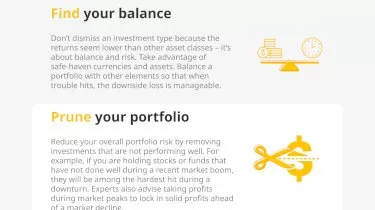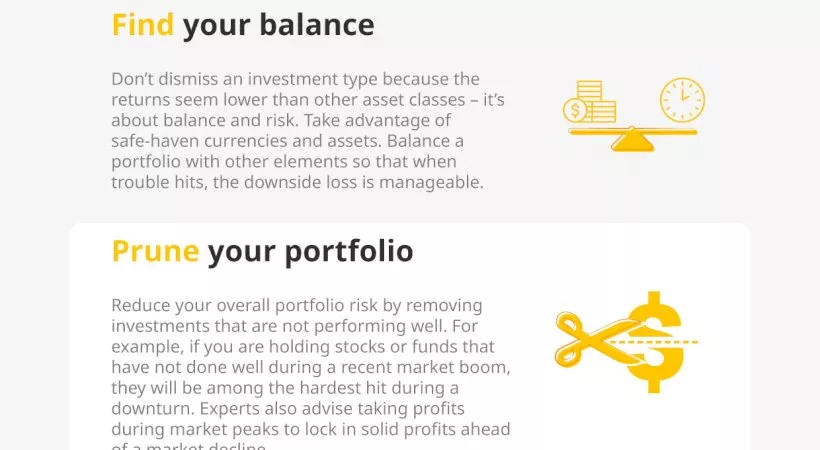Invest
3 ways to pandemic-proof a portfolio
There are a number of lessons high-net-worth investors can teach the rest of us about wealth preservation during a downturn, according to an investment specialist.

3 ways to pandemic-proof a portfolio
There are a number of lessons high-net-worth investors can teach the rest of us about wealth preservation during a downturn, according to an investment specialist.

In an opinion piece for nestegg’s sister brand InvestorDaily, Citi investment specialist Jonathen Chan said high-net-worth individuals are usually attuned to world events and will seek out defensive portfolio allocations that focus on wealth preservation.
“This prepares them well for periods of volatility, even unpredictable volatility like COVID-19,” he considered.
“Everyone can take a leaf from this book, as uncertainty is on the cards for the foreseeable future.”
He highlighted three main lessons that everyday investors can take from the high-net-worth investor playbook.
- Don’t try to time the market
For investors that try to time the market, COVID-19 “has been and continues to be a wild and sometimes scary ride”, Mr Chan said.
The opposite is true for long-term investors with an asset mix “that allows for absorption of volatility”.
According to the investment specialist, high-net-worth investors tend to be more cautious in their approach, as protecting their wealth forms a key part of their portfolio planning.
“Instead of chasing high returns but high risk opportunities, investments to them is about steadily growing their portfolio and limiting the downside,” he said.
- Diversification is the only free lunch
“In the wealth management industry we have a saying, ‘diversification is the only free lunch’. This saying has certainly proved true while navigating the impacts of the pandemic.”
Mr Chan has observed that Australians traditionally concentrate their investments in property, shares and cash: “The first two suffer in downturns, and the latter is certainly not king in the current low-interest environment.”
He advises that more asset classes need to be considered, particularly in times of volatility.
Noting a move by high-net-worth investors towards bonds, term deposits and hedged equities (structured investments), Mr Chan said these individuals have “managed solid portfolio performance at a time when risk in equities was escalating”.
While some investors would have made higher returns out of straight equities, the investment specialist argued they would have been the minority.
“Most investors tend to wait for more gains as equities rally, and get caught in the panic selling when markets suddenly fall,” he explained.
- Learn about and use different asset classes
“Australians are overweight to shares,” Mr Chan reiterated, while conceding that the benefits of holding shares is fast diminishing.
It’s why, again, the investment specialist touted the benefits of other asset classes – term deposits, corporate bonds and managed funds “just to name a few”.
From Mr Chan’s perspective, “investors should remember to not just dismiss an investment type because the returns seem lower than other asset classes – it’s about balance and risk”.
Another trend of high-net-worth individuals that is rising in popularity throughout the pandemic is diversification through holding investments in multiple currencies.
“This is to take advantage of the benefits of safe-haven currencies like the US dollar and the Japanese yen in times of high risk, and the strengthening of the Australian dollar as risk lowers,” he explained.
While it’s okay to heavily invest in the sharemarket, Mr Chan has advised that “it remains important to learn how to balance a portfolio with other elements, so that when trouble hits, the downside loss is manageable”.
About the author

About the author


Investment insights
Orbis Investments challenges investors to rethink assumptions in 2026
In a bold move to reshape investor perspectives, Orbis Investments has released a new report titled "Six Courageous Questions for 2026," encouraging investors to critically evaluate their assumptions ...Read more

Investment insights
Rate relief on the horizon? How a November cut could reshape Australian balance sheets
With unemployment edging up to a multi-year high, markets are weighing whether the Reserve Bank will pivot to a rate cut as early as November. For CFOs and CEOs, the real question isn’t if a cut lan...Read more

Investment insights
J.P. Morgan unveils insights from the world's wealthiest families in 2025 report
In a world increasingly defined by rapid technological advancements and global uncertainties, J.P. Morgan has released its 2025 Principal Discussions Report, offering a unique glimpse into the minds o...Read more

Investment insights
RBA keeps the playbook open: how to navigate an “anything-can-happen” rate path
The Reserve Bank has kept its options open on interest rates, signalling neither cuts nor hikes are off the table. For boards and CFOs, that ambiguity is not a bug — it’s the game. With the cash r...Read more

Investment insights
Hotter CPI, cooler cuts: What the RBA pause means for balance sheets, pricing and 2025 strategy
A surprise upside in quarterly inflation has shifted the Reserve Bank of Australia’s calculus: a cut now looks less likely, and a prolonged plateau in rates more probable. For CFOs, that changes the...Read more

Investment insights
Gold demand hits record highs as investors seek refuge from market volatility
Global gold demand surged to record levels in the September quarter as investors sought safety amid volatile markets and growing geopolitical uncertainty, according to the World Gold Council’s Q3 20...Read more

Investment insights
Global deal activity dips 4% amid cautious investor sentiment: GlobalData
Global deal activity has declined by 4 per cent year-on-year during the first three quarters of 2025 as deal-making slowed across regions and sectors, according to data and analytics firm GlobalData. ...Read more

Investment insights
RBA easing risk returns: How a possible November cut reshapes capital, currency and competitiveness
A four-year high in unemployment has put the Reserve Bank of Australia back in play, with major sell-side houses flagging a live risk of a November rate cut. For CFOs and boards, this is more than a h...Read more

Investment insights
Orbis Investments challenges investors to rethink assumptions in 2026
In a bold move to reshape investor perspectives, Orbis Investments has released a new report titled "Six Courageous Questions for 2026," encouraging investors to critically evaluate their assumptions ...Read more

Investment insights
Rate relief on the horizon? How a November cut could reshape Australian balance sheets
With unemployment edging up to a multi-year high, markets are weighing whether the Reserve Bank will pivot to a rate cut as early as November. For CFOs and CEOs, the real question isn’t if a cut lan...Read more

Investment insights
J.P. Morgan unveils insights from the world's wealthiest families in 2025 report
In a world increasingly defined by rapid technological advancements and global uncertainties, J.P. Morgan has released its 2025 Principal Discussions Report, offering a unique glimpse into the minds o...Read more

Investment insights
RBA keeps the playbook open: how to navigate an “anything-can-happen” rate path
The Reserve Bank has kept its options open on interest rates, signalling neither cuts nor hikes are off the table. For boards and CFOs, that ambiguity is not a bug — it’s the game. With the cash r...Read more

Investment insights
Hotter CPI, cooler cuts: What the RBA pause means for balance sheets, pricing and 2025 strategy
A surprise upside in quarterly inflation has shifted the Reserve Bank of Australia’s calculus: a cut now looks less likely, and a prolonged plateau in rates more probable. For CFOs, that changes the...Read more

Investment insights
Gold demand hits record highs as investors seek refuge from market volatility
Global gold demand surged to record levels in the September quarter as investors sought safety amid volatile markets and growing geopolitical uncertainty, according to the World Gold Council’s Q3 20...Read more

Investment insights
Global deal activity dips 4% amid cautious investor sentiment: GlobalData
Global deal activity has declined by 4 per cent year-on-year during the first three quarters of 2025 as deal-making slowed across regions and sectors, according to data and analytics firm GlobalData. ...Read more

Investment insights
RBA easing risk returns: How a possible November cut reshapes capital, currency and competitiveness
A four-year high in unemployment has put the Reserve Bank of Australia back in play, with major sell-side houses flagging a live risk of a November rate cut. For CFOs and boards, this is more than a h...Read more








